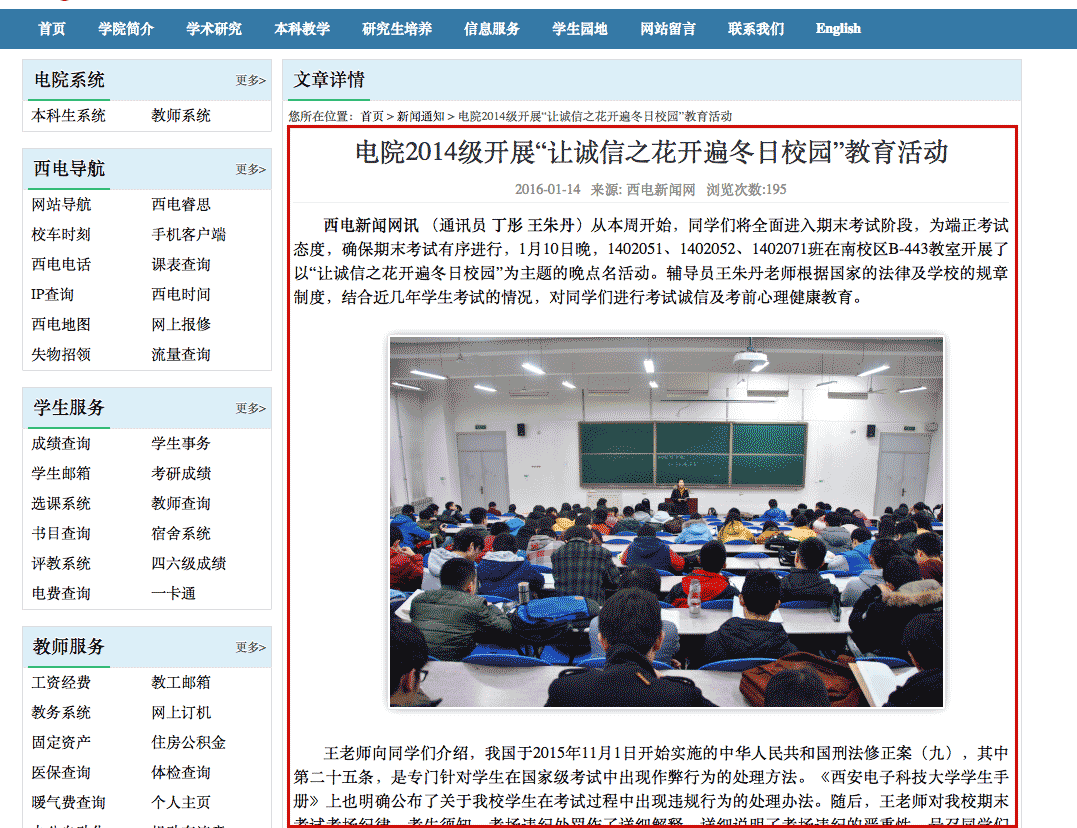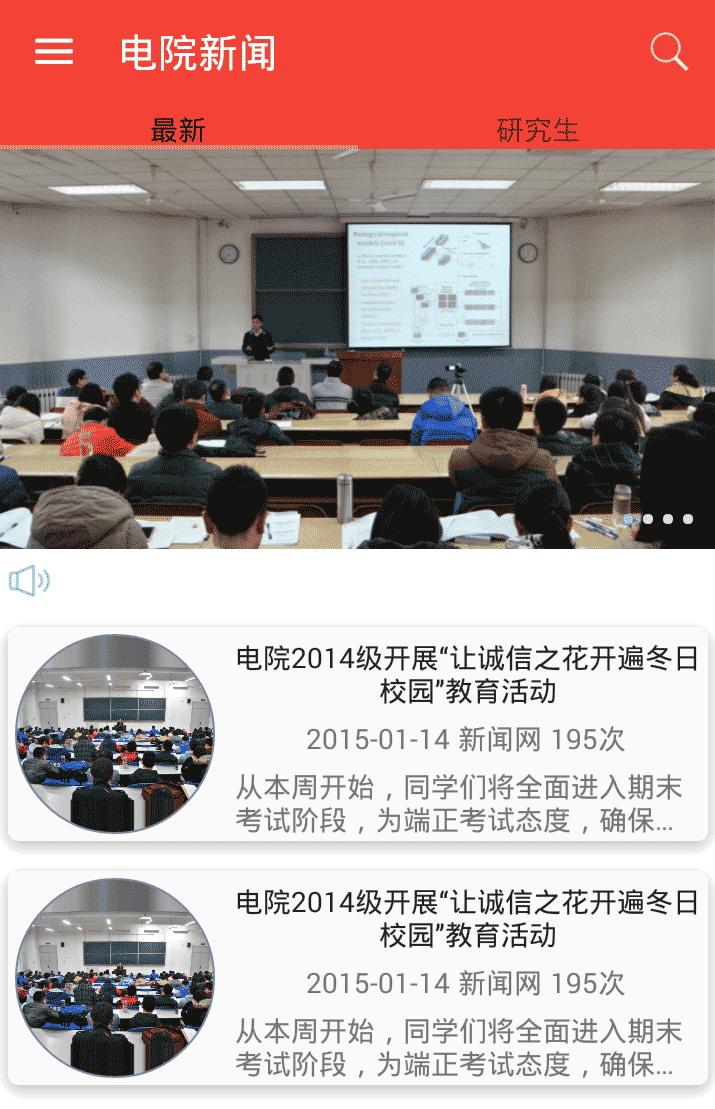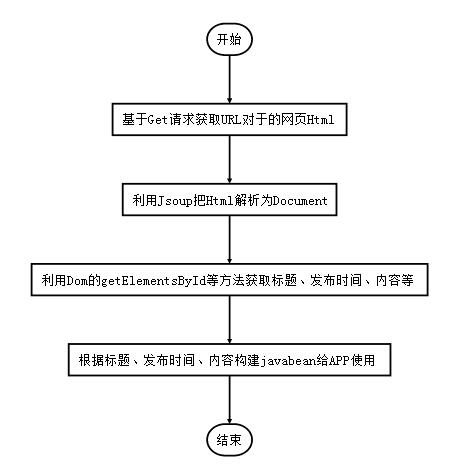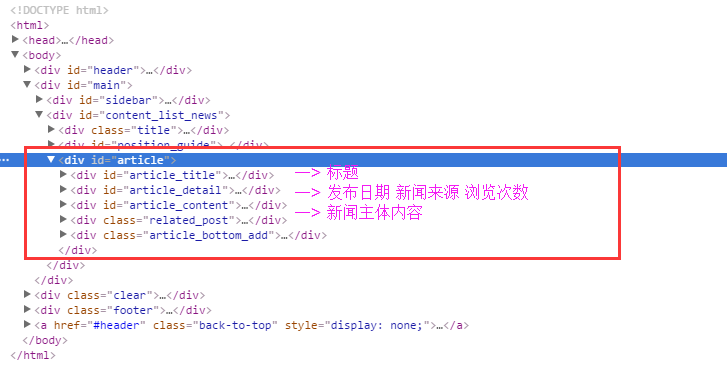一、需求
最近基于 Material Design 重构了自己的新闻 App,数据来源是个问题。
有前人分析了知乎日报、凤凰新闻等 API,根据相应的 URL 可以获取新闻的 JSON 数据。为了锻炼写代码能力,笔者打算爬虫新闻页面,自己获取数据构建 API。
二、效果图
下图是原网站的页面

爬虫获取了数据,展示到 APP 手机端

三、爬虫思路

关于App 的实现过程可以参看这几篇文章,本文主要讲解一下如何爬虫数据。
Jsoup 简介
Jsoup 是一个 Java 的开源HTML解析器,可直接解析某个URL地址、HTML文本内容。
Jsoup主要有以下功能:
- - 从一个URL,文件或字符串中解析HTML;
- - 使用DOM或CSS选择器来查找、取出数据;
- - 对HTML元素、属性、文本进行操作;
- - 清除不受信任的HTML (来防止XSS攻击)
四、爬虫过程
Get 请求获取网页 HTML
新闻网页Html的DOM树如下所示:

下面这段代码根据指定的 url,用代码获取get 请求返回的 html 源代码。
|
1
2
3
4
5
6
7
8
9
10
11
12
13
14
15
16
17
18
19
20
21
22
|
public static String doGet(String urlStr) throws CommonException { URL url; String html = ""; try { url = new URL(urlStr); HttpURLConnection connection = (HttpURLConnection) url.openConnection(); connection.setRequestMethod("GET"); connection.setConnectTimeout(5000); connection.setDoInput(true); connection.setDoOutput(true); if (connection.getResponseCode() == 200) { InputStream in = connection.getInputStream(); html = StreamTool.inToStringByByte(in); } else { throw new CommonException("新闻服务器返回值不为200"); } } catch (Exception e) { e.printStackTrace(); throw new CommonException("get请求失败"); } return html;} |
InputStream in = connection.getInputStream();将得到输入流转化为字符串是个普遍需求,我们将其抽象出来,写一个工具方法。
|
1
2
3
4
5
6
7
8
9
10
11
12
13
|
public class StreamTool { public static String inToStringByByte(InputStream in) throws Exception { ByteArrayOutputStream outStr = new ByteArrayOutputStream(); byte[] buffer = new byte[1024]; int len = 0; StringBuilder content = new StringBuilder(); while ((len = in.read(buffer)) != -1) { content.append(new String(buffer, 0, len, "UTF-8")); } outStr.close(); return content.toString(); }} |
五、解析 HTML 获取标题
利用 google 浏览器的审查元素,找出新闻标题对于的html 代码:
|
1
2
3
4
5
6
7
|
<div id="article_title"> <h1> <a href="http://see.xidian.edu.cn/html/news/7428.html"> 关于举办《经典音乐作品欣赏与人文审美》讲座的通知 </a> </h1></div> |
我们需要从上面的 HTML 中找出id="article_title"的部分,使用 getElementById(String id) 方法
|
1
2
3
4
5
6
7
8
9
|
String htmlStr = HttpTool.doGet(urlStr);// 将获取的网页 HTML 源代码转化为 DocumentDocument doc = Jsoup.parse(htmlStr);Element articleEle = doc.getElementById("article");// 标题Element titleEle = articleEle.getElementById("article_title");String titleStr = titleEle.text(); |
六、获取发布日期、信息来源
同样找出对于的 HTML 代码
|
1
2
3
4
5
6
7
8
9
10
11
|
<html> <head></head> <body> <div id="article_detail"> <span> 2015-05-28 </span> <span> 来源: </span> <span> 浏览次数: <script language="JavaScript" src="http://see.xidian.edu.cn/index.php/news/click/id/7428"> </script> 477 </span> </div> </body></html> |
思路也和上面类似,使用 getElementById(String id) 方法找出id="article_detail"为Element,再利用getElementsByTag获取span 部分。因为一共有3个<span> ... </span>,所以返回的是Elements而不是Element。
|
1
2
3
4
5
6
7
8
9
|
// article_detail包括了 2016-01-15 来源: 浏览次数:177Element detailEle = articleEle.getElementById("article_detail");Elements details = detailEle.getElementsByTag("span");// 发布时间String dateStr = details.get(0).text();// 新闻来源String sourceStr = details.get(1).text(); |
七、解析浏览次数
如果打印出上面的details.get(2).text(),只会得到
浏览次数:
没有浏览次数?为什么呢?
因为浏览次数是JavaScript 渲染出来的, Jsoup爬虫可能仅仅提取HTML内容,得不到动态渲染出的数据。
解决方法有两种
- 在爬虫的时候,内置一个浏览器内核,执行js渲染页面后,再抓取。这方面对应的工具有Selenium、HtmlUnit或者PhantomJs。
- 所以分析JS请求,找到对应数据的请求url
如果你访问上面的 urlhttp://see.xidian.edu.cn/index.php/news/click/id/7428,会得到下面的结果
|
1
|
document.write(478) |
这个478就是我们需要的浏览次数,我们对上面的url做get 请求,得到返回的字符串,利用正则找出其中的数字。
|
1
2
3
4
5
|
// 访问这个新闻页面,浏览次数会+1,次数是 JS 渲染的String jsStr = HttpTool.doGet(COUNT_BASE_URL + currentPage);int readTimes = Integer.parseInt(jsStr.replaceAll("\D+", ""));// 或者使用下面这个正则方法// String readTimesStr = jsStr.replaceAll("[^0-9]", ""); |
八、解析新闻内容
本来是获取新闻内容纯文字的形式,但后来发现 Android 端也可以显示 CSS 格式,所以后来内容保留了 HTML 格式。
|
1
2
3
4
5
6
|
Element contentEle = articleEle.getElementById("article_content");// 新闻主体内容String contentStr = contentEle.toString();// 如果用 text()方法,新闻主体内容的 html 标签会丢失// 为了在 Android 上用 WebView 显示 html,用toString()// String contentStr = contentEle.text(); |
九、解析图片 Url
注意一个网页上大大小小的图片很多,为了只获取新闻正文中的内容,我们最好首先定位到新闻内容的Element,然后再利用getElementsByTag(“img”)筛选出图片。
|
1
2
3
4
5
6
7
8
9
10
11
12
|
Element contentEle = articleEle.getElementById("article_content");// 新闻主体内容String contentStr = contentEle.toString();// 如果用 text()方法,新闻主体内容的 html 标签会丢失// 为了在 Android 上用 WebView 显示 html,用toString()// String contentStr = contentEle.text();Elements images = contentEle.getElementsByTag("img");String[] imageUrls = new String[images.size()];for (int i = 0; i < imageUrls.length; i++) { imageUrls[i] = images.get(i).attr("src");} |
十、新闻实体类 JavaBean
上面获取了新闻的标题、发布日期、阅读次数、新闻内容等等,我们自然需要构造一个 javabean,把获取的内容封装进实体类中。
- public class ArticleItem {
- private int index;
- private String[] imageUrls;
- private String title;
- private String publishDate;
- private String source;
- private int readTimes;
- private String body;
- public ArticleItem(int index, String[] imageUrls, String title, String publishDate, String source, int readTimes,
- String body) {
- this.index = index;
- this.imageUrls = imageUrls;
- this.title = title;
- this.publishDate = publishDate;
- this.source = source;
- this.readTimes = readTimes;
- this.body = body;
- }
- @Override
- public String toString() {
- return "ArticleItem [index=" + index + ", imageUrls=" + Arrays.toString(imageUrls) + ", title=" + title
- + ", publishDate=" + publishDate + ", source=" + source + ", readTimes=" + readTimes + ", body=" + body
- + "]";
- }
- }
测试
|
1
2
3
4
5
6
7
8
9
10
11
12
13
14
15
16
17
18
19
20
21
22
23
24
25
26
27
28
29
30
31
32
33
34
35
36
37
38
39
40
41
42
43
44
45
46
47
48
49
|
public static ArticleItem getNewsItem(int currentPage) throws CommonException { // 根据后缀的数字,拼接新闻 url String urlStr = ARTICLE_BASE_URL + currentPage + ".html"; String htmlStr = HttpTool.doGet(urlStr); Document doc = Jsoup.parse(htmlStr); Element articleEle = doc.getElementById("article"); // 标题 Element titleEle = articleEle.getElementById("article_title"); String titleStr = titleEle.text(); // article_detail包括了 2016-01-15 来源: 浏览次数:177 Element detailEle = articleEle.getElementById("article_detail"); Elements details = detailEle.getElementsByTag("span"); // 发布时间 String dateStr = details.get(0).text(); // 新闻来源 String sourceStr = details.get(1).text(); // 访问这个新闻页面,浏览次数会+1,次数是 JS 渲染的 String jsStr = HttpTool.doGet(COUNT_BASE_URL + currentPage); int readTimes = Integer.parseInt(jsStr.replaceAll("\D+", "")); // 或者使用下面这个正则方法 // String readTimesStr = jsStr.replaceAll("[^0-9]", ""); Element contentEle = articleEle.getElementById("article_content"); // 新闻主体内容 String contentStr = contentEle.toString(); // 如果用 text()方法,新闻主体内容的 html 标签会丢失 // 为了在 Android 上用 WebView 显示 html,用toString() // String contentStr = contentEle.text(); Elements images = contentEle.getElementsByTag("img"); String[] imageUrls = new String[images.size()]; for (int i = 0; i < imageUrls.length; i++) { imageUrls[i] = images.get(i).attr("src"); } return new ArticleItem(currentPage, imageUrls, titleStr, dateStr, sourceStr, readTimes, contentStr);}public static void main(String[] args) throws CommonException { System.out.println(getNewsItem(7928));} |
输出信息
|
1
2
3
4
5
6
7
8
|
ArticleItem [index=7928, imageUrls=[/uploads/image/20160114/20160114225911_34428.png], title=电院2014级开展“让诚信之花开遍冬日校园”教育活动, publishDate=2016-01-14, source=来源: 电影新闻网, readTimes=200, body=<div id="article_content"> <p style="text-indent:2em;" align="justify"> <strong><span style="font-size:16px;line-height:1.5;">西电新闻网讯</span></strong><span style="font-size:16px;line-height:1.5;"> (通讯员</span><strong><span style="font-size:16px;line-height:1.5;"> 丁彤 王朱丹</span></strong><span style="font-size:16px;line-height:1.5;">...) |
本文讲解了如何实现Jsoup 网络爬虫,如果文章对您有帮助,那就给个赞吧。
















